 |
|
 |
| |
發行人:林恭如所長 編輯委員:吳肇欣教授 主編:林筱文 發行日期:2018.07.30 |
| |
|
 |
Ultrahigh Responsivity and Superior Sensitivity Graphene-semiconducting Light Absorber Hybrid Phototransistors
Professor Chih-I Wu
Graduate Institute of Photonics and
Optoelectronics, National Taiwan University
臺灣大學光電所 吳志毅教授
Graphene−semiconducting light absorber hybrid photodetectors have attracted increasing attention because of their ultrahigh photoconductive gain and superior sensitivity. However, most graphene based hybrid photodetectors reported previously have shown a relatively long response time caused by numerous long-lived traps in these hybrid systems, which greatly restricts device speed. In our studies, we found graphene/light-harvesting materials (such as thieno[3,4-b]thiophene/ benzodithiophene polymer (PTB7) and Bismuth(III) iodide (BiI3)) hybrid photodetectors have high responsivity and short photocurrent response time. Figure 1 shows the graphene-PTB7 hybrid photodetectors fabricated on self-assembled-monolayer functionalized SiO2 substrates with a maximum responsivity of ~ 1.8 ×105 A/W and a relatively short photocurrent response time of ~ 7.8 ms.
Besides, the graphene/BiI3 vertical heterostructure phototransistors also have a maximum responsivity of about 6×106 A/W , EQEs of up to 106 % in the visible light region, relatively short photocurrent response times of ~ 8 ms, and detectivity of 7×1014 Jones under the SNL condition. Compared to BiI3 on bare SiO2 substrates, the thermally evaporated BiI3 films on graphene sheets possessed nearly flatter morphologies and remarkably better crystallinities because of the weak van der Waals interactions between graphene and BiI3. In Figure 2, the photoemission spectra of graphene/BiI3 heterojunctions also manifest the evidence that no chemical interactions occur between graphene and BiI3, resulting in the van der Waals epitaxial growth. The measured band bending consistently illustrates that photo-induced charge transfer occurs at the graphene/BiI3 interface. The high-quality crystal growth of the layered metal halide BiI3 could make graphene/BiI3 heterostructures a promising building block for high-performance optoelectronic applications.
|

|
|
Figure 1. (a) Schematic illustration of a graphene−PTB7 hybrid photodetector (b) Rise time and (c) fall time of the device |
|
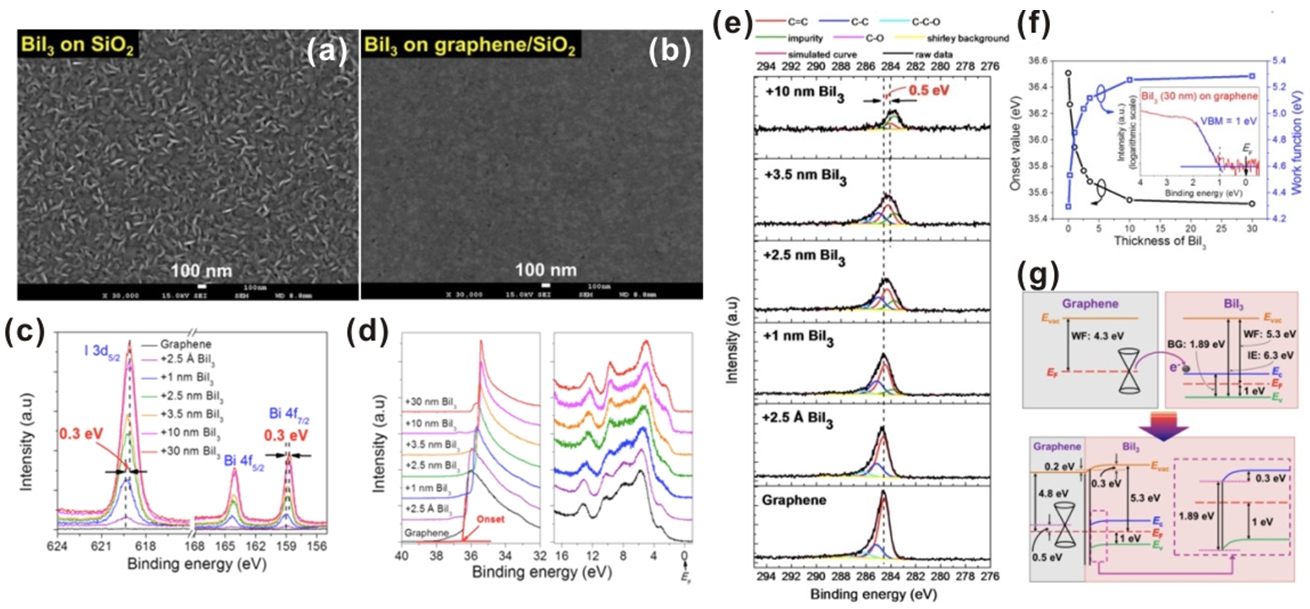
|
|
Figure 2. SEM images of 50 nm thermally evaporated BiI3 film on (a) SiO2 and (b) graphene/SiO2. Photoemission spectra of graphene with incrementally increased BiI3 film thickness. (c) XPS spectra of I3d5/2 and Bi4f. (d) UPS spectra for SEC (left) and VB (right) regions, respectively. (e) C1s
peak-fitting XPS spectra. (f) The onset values of the SEC spectra (black dot) and the corresponding WFs (blue dot) as a function of the BiI3 thickness. The inset shows the VB maximum position of bulk BiI3. (g) Individual electronic structures of pristine graphene and BiI3. The energy level alignment and band bending at the graphene/BiI3 heterojunction are depicted in the bottom panel. |
Reference :
1. Chang P. H., Tsai Y.C., Shen S. W., Liu S.Y., Huang K. Y., Li C. S. Chang, H. P., and Wu C. I., Highly Sensitive Graphene−Semiconducting Polymer Hybrid Photodetectors
with Millisecond Response Time,
ACS Photonics
2017,
4, 2335−2344
2.
Chang P. H., Li C. S., Fu F. Y, Huang K. Y, Chou A. S.,
and Wu C. I., Ultrasensitive Photoresponsive Devices Based on Graphene/BiI3 van
der Waals Epitaxial Heterostructures,
Advanced Functional Materials
2018,
28, 1800179
|
 |
| |
|
|
|
 |
|
| |
|
 |
論文題目:全域式光學同調斷層掃描儀於皮膚組織之量化參數研究
姓名:張家凱 指導教授:黃升龍教授
| 摘要 |
|
以往的生物細胞分析是透過二維影像來建立量化資訊,我們通過解析度為橫向0.8 µm,縱向0.9 µm的全域式同調斷層掃描(FF-OCT)系統,獲取三維斷層掃描立體影像,以三維立體資訊來分析,可以得到較全面的資訊。本研究開發隨機射線取樣(Random rayburst sampling; RRBS)框架,用於檢測三維空間中的細胞核與細胞膜的邊界,從而進行單細胞的量化分析,計算出單細胞的體積核質比(nuclear-to-cytoplasmic ratio)與細胞立體形貌(圖一)。RRBS對雜訊不敏感,不同隨機選擇的RRBS計算所得到的體積核質比之間的相對標準偏差為2%。以螢光共焦顯微鏡做驗證,RRBS算法於體積核質比的誤差僅為1%。為了提升計算效率,本研究使用圖形處理器(Graphics processing unit; GPU)的平行計算,若使用Nvidia的GTX 1080圖形處理器,於三維雙邊濾波器之計算可以得到280倍的速度提升。
RRBS框架也可應用於活體皮膚組織的量化分析(圖二)。角質形成細胞(Keratinocytes)之細胞核的體積由顆粒層(Stratum granulosum)到基底層(Stratum basale)逐漸變小,結合FF-OCT的快速三維斷層掃描與RRBS框架可以提取位於表皮層(Epidermis)不同深度的角質形成細胞之細胞核的三維形態特徵,進而對活體皮膚進行量化分析,角質形成細胞核在基底層的平均縱向和橫向直徑分別為5.1±0.34和7.2±0.74 µm,RRBS框架與本實驗室的細胞等級高解析度FF-OCT搭配,有潛力作為皮膚之疾病與癌症的早期診斷的有效方法。
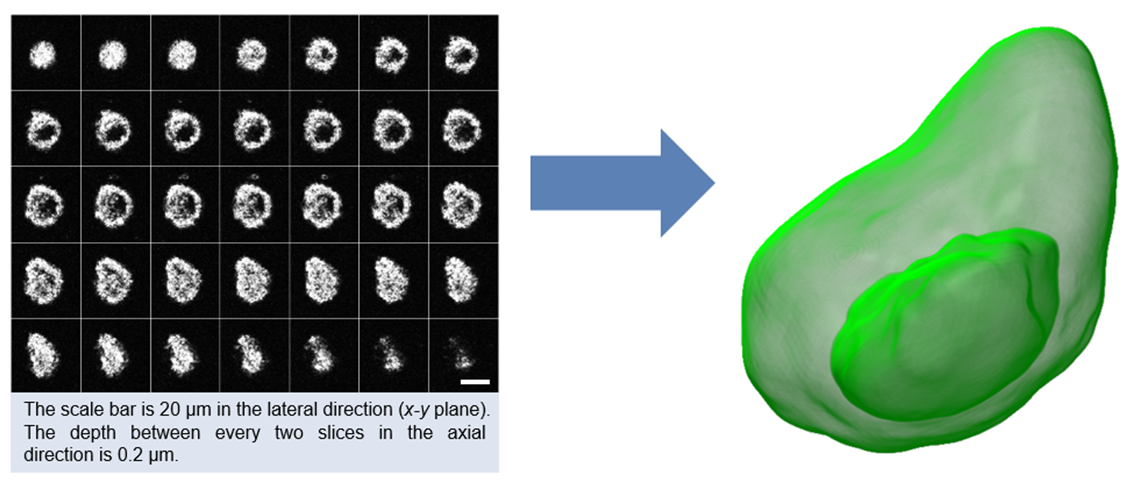 |
|
圖一 |
|
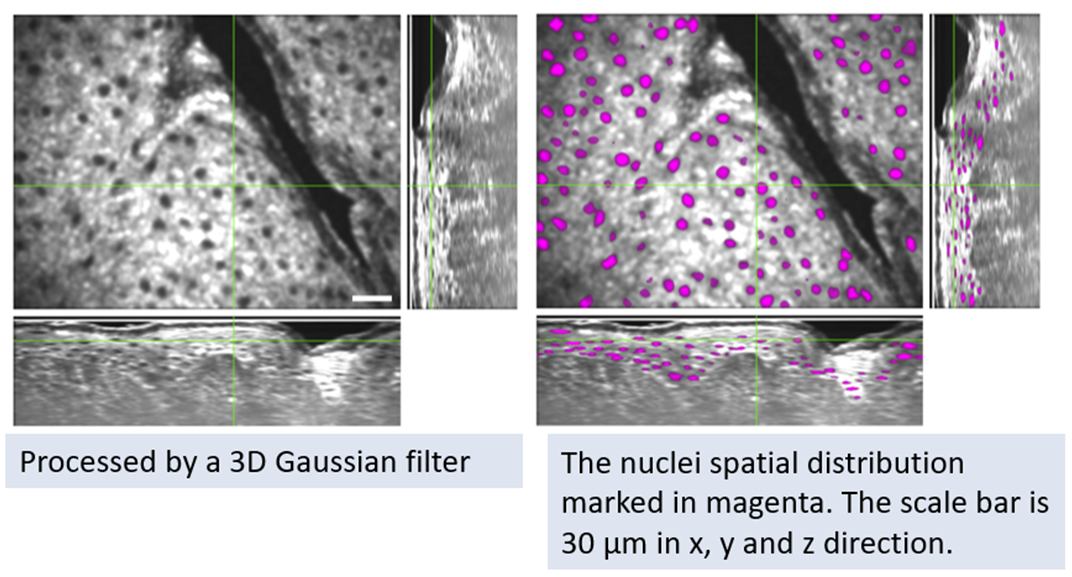 |
|
圖二 |
|
|
|
 |
|
 |
|
| |
|
 |
—
資料提供:影像顯示科技知識平台 (DTKP, Display Technology
Knowledge Platform) —
—
整理:林晃巖教授、孟慶棠 —
偏振特性決定全球定位
海洋動物能否使用偏振敏感視覺作為在水底的自然全球定位系統?根據最近由美國和澳大利亞的計算機科學家、海洋生物學家和物理學家進行的一項研究(Sci. Adv.
4, eaao6841; 2018),結果是此項功能是可行的。該團隊的實驗數據和分析顯示,太陽的位置(朝向和仰角)可以根據水下的光線偏振模式來確定,因此如果觀測者了解時間和日期,則可以推斷出他們在全球的位置。這種水底偏振圖案是藉由日光的折射和散射的組合而產生的。特別的是,穿過天空/海洋邊界的空氣/水界面的太陽光在入射和折射光線的平面內以其特徵產生偏振。同時,部分散射使與該平面垂直的光產生偏振。這些組合之效果隨著太陽位置而變產生許多變化的偏振模式。
為了測試他們的假設,該團隊建立了一個水下偏振敏感相機,如圖一(A)所示。其中由平行鋁奈米線所製成的偏振濾波器,以0°、45°、90°和135°的角度對準,並沉積在2兆像素的感光元件上,如圖一(B)所示。這種擺置允許攝像機捕捉光強度,部分偏振和偏振角影像,並模仿螳螂蝦的視覺系統。然後使用相機在世界各地不同的地點(澳大利亞、夏威夷、佛羅里達和芬蘭)、不同的水深(2-20米)以及從日出到日落中不同的時間來拍攝實驗數據。其結果顯示使用這種系統的導航是可能的,其每行進1公里的誤差約為6米。
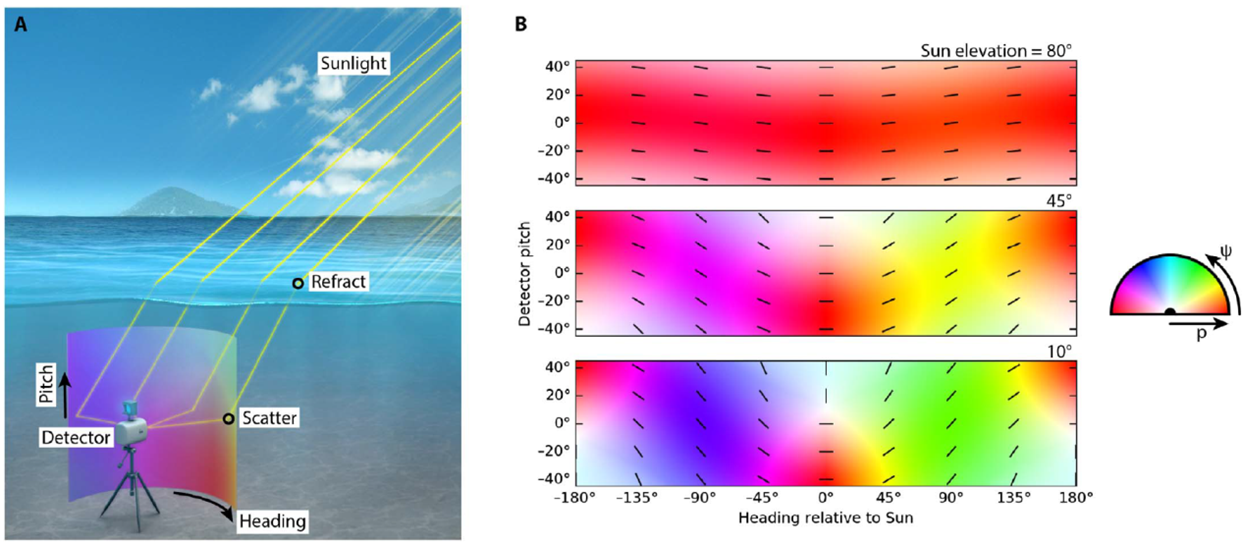 |
|
圖一、水底極化系統示意圖。(A) 圓柱體顯示檢測器觀察到的偏振態。(B) 單一散射模型可預測的偏振態在太陽升起高於水平面10°、45°和80°(見右圖)。為了清楚起見,以偏振角為方向的線覆蓋在圖上。偏振的中性點發生於散射之偏振狀態抵消折射之偏振狀態時
。 |
因為幾種海洋動物具有極化敏感的視覺,因此它們可能將其視覺用作指南針,應用於長途水底導航和地理定位。而此已經被許多陸生節肢動物,如:螞蟻、蜜蜂、甲蟲和蜘蛛,其使用光的極化作為導航輔助已獲證實。儘管該團隊的測量只發生在四個不同的全球地點(如圖二),但他們認為依據海水一致性之特性代表該方法具有普遍的適用性。
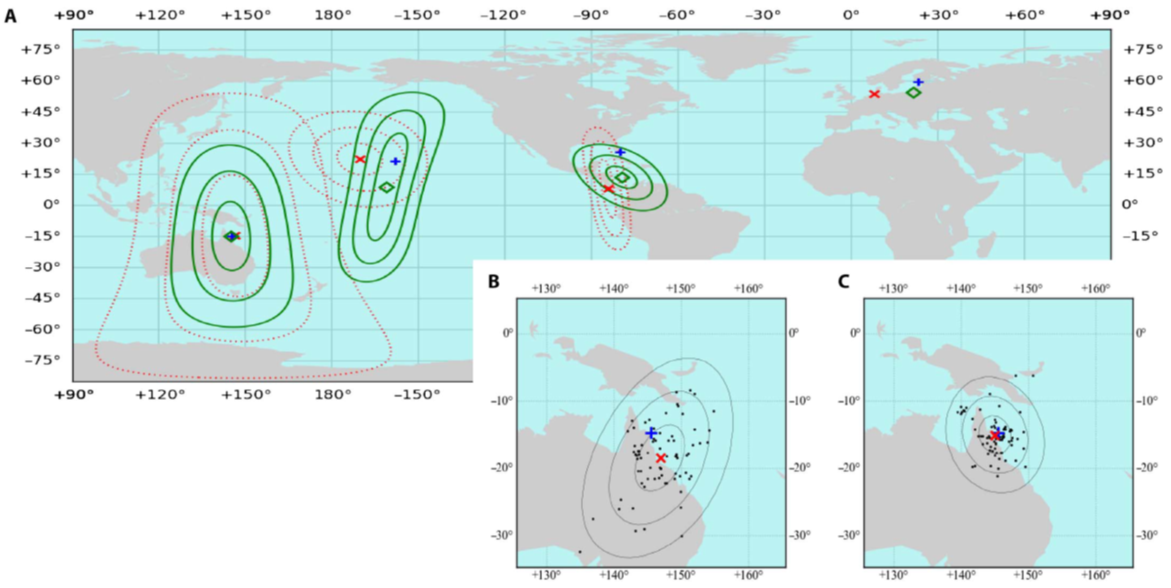 |
|
圖二、(A) 澳大利亞、夏威夷、佛羅里達和芬蘭四個測試地點的位置評估。藍色十字為測試點位置;紅色叉叉與虛線為單一散射評估的結果;綠色菱形與曲線為使用k-最近相鄰回歸法評估的結果。(B) 單一散射評估的結果。(C) k-最近相鄰回歸法評估的結果。 |
|
參考資料: |
[1] Oliver Graydon, “Global position by polarization,” Nature Photonics, volume 12, page 318 (2018)
https://www.nature.com/articles/s41566-018-0187-3
DOI: 10.1038/s41566-018-0187-3
[2] Samuel B. Powell, Roman Garnett, Justin Marshall, Charbel Rizk, Viktor Gruev, “Contact Lenses for Color Blindness,” Sci Adv, 4 (4), eaao6841(2018).
http://advances.sciencemag.org/content/4/4/eaao6841
DOI: 10.1126/sciadv.aao6841
|
| |
|
|
|
|
|
|
|
|
|
 |
|
 |
|
|
|
 |
|
 |
|